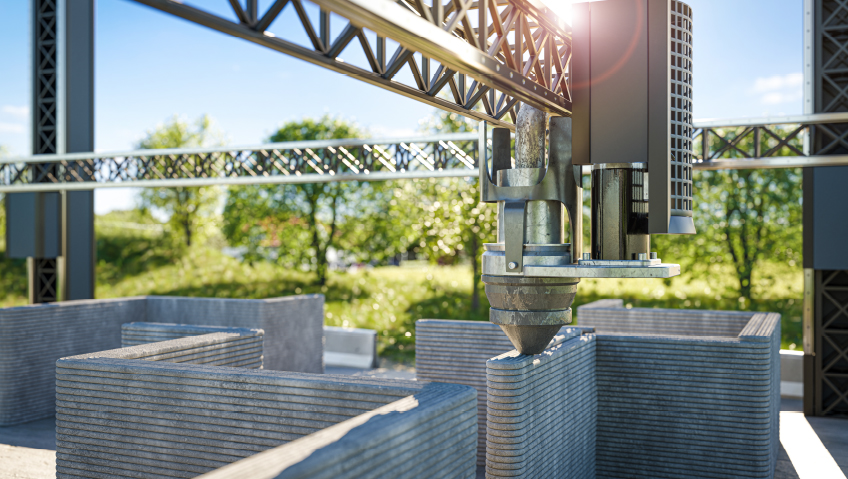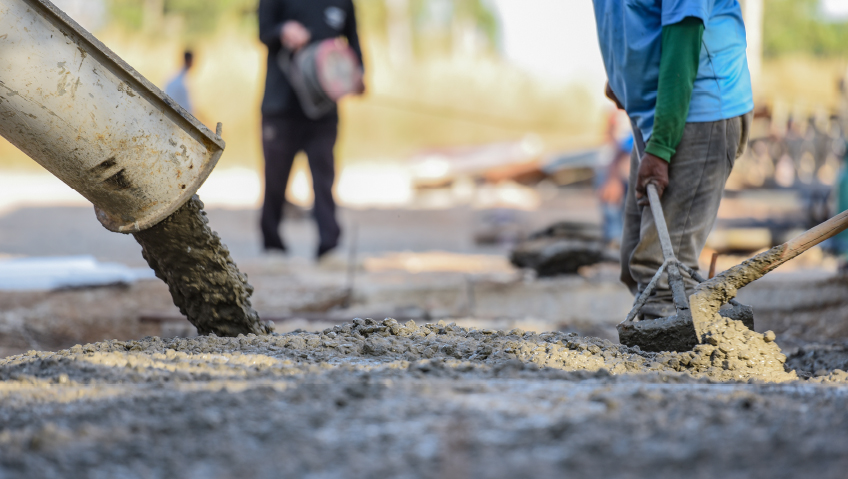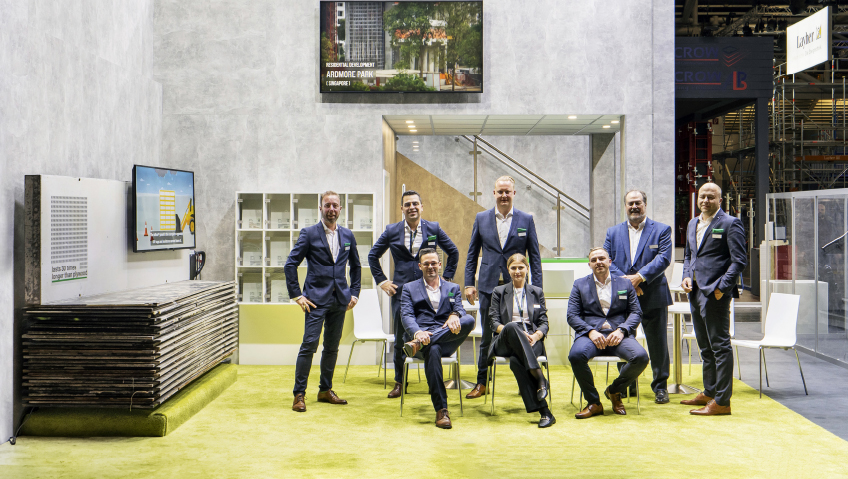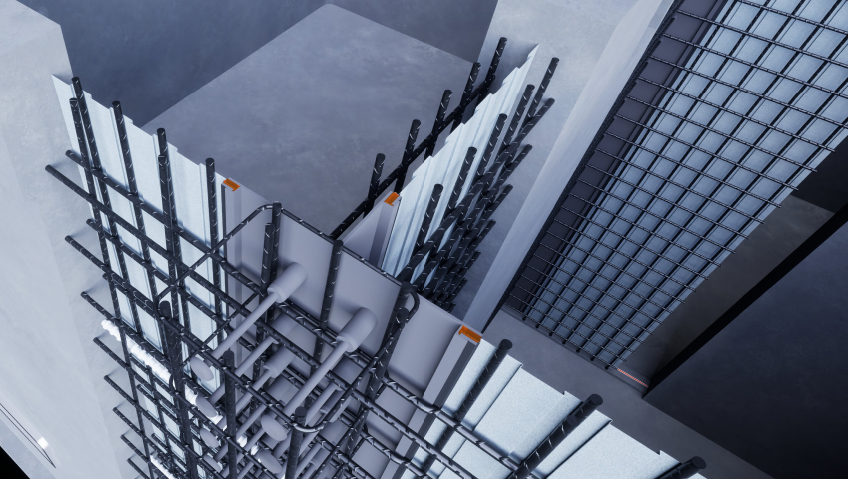While there have been many advancements made recently in the world of concrete, three-dimensional concrete printing (C3DP) is one of the biggest technological innovations seen in the building sector in recent years. This technique brings a totally revolutionary approach to classic designs by integrating additive manufacturing principles with traditional building material, with specially-formulated concrete and cement mixtures creating 3D objects layer by layer with large-scale printers.
By reducing wait times and increasing design flexibility to create complicated shapes that are typically challenging to construct using traditional methods, C3DP transforms building operations and design, reduces waste, and offers sustainable solutions for a variety of projects including houses, bridges, wind turbines, coral reefs, and benches.
According to 3D Sourced, the C3DP industry forecasted a market valuation of $1.575 million in 2024, with a key factor being concrete molds allowing for the construction of entire structures within a single day, offering incredible time and cost savings.
Parametric Architecture explains that C3DP operates on similar principles to other additive manufacturing techniques. First, a digital model of the planned building is created using computer-aided design (CAD) software. This model is then divided into horizontal layers, which the printer will adhere to during building. The printer is often either an arranging system or a robotic arm with a nozzle that allows concrete mix to be forced through. The concrete used in 3D printing is specially blended to have the necessary viscosity and curing properties to maintain structural integrity when layers of the material are placed.
The printer is extremely accurate, with layers deposited in a sequential manner in accordance with the parameters of the digital model. Ensuring these layers of concrete adhere to one another while maintaining their structural integrity and form requires precise control over the concrete’s curing time as well as the environmental factors inside the printing plant.
When it comes to practical uses for C3DP in the building industry, there are many, with residential development being the most notable, according to Parametric Architecture. Already found around the world, C3DP represents a practical way to build affordable, sturdy, and aesthetically pleasing dwellings. Concrete printing has also been used in commercial projects and public facility development in addition to residential buildings, with a vast variety of constructions, such as office buildings, bridges, and even public areas like park benches and pavilions, having been created.
There is also promise of this technology being used in disaster response and emergency assistance, with C3DP making it possible to produce sturdy structures swiftly, providing immediate defense against natural disasters like earthquakes, hurricanes, and floods, particularly in situations where using conventional building techniques can be too cumbersome or slow.
Space exploration is also being impacted by C3DP. With the use of this technology, NASA and other space agencies can build habitats on the Moon and Mars that are resistant to the harsh conditions of space travel.
In addition to tackling global concerns including housing shortages and sustainable development challenges, 3D concrete printing can also boost efficacy and attractiveness. Along with this method making for a greener construction industry by reducing material waste and enabling the use of eco-friendly concrete in buildings, another significant benefit is a shortened building time, according to Parametric Architecture. 3D printing is comparatively speedy in comparison to traditional construction methods, which can take months or even years.
Versatility is also key. Unlike conventional manufacturing techniques, 3D printing makes it possible to create objects with elaborate patterns and complex structures, allowing architects to easily experiment.
Cost-effectiveness is another benefit. By essentially eliminating a significant portion of the construction process, C3DP lowers labor costs by reducing the number of workers required while creating precisely what is needed for a certain building or structure, reducing the amount of material waste, lowering material costs, and promoting ecological construction techniques.
According to 3D Printing Industry, aside from creating a unique beauty, C3DP offers significant cost and lead time advantages over traditional building, which is why the technology is being employed more and more in construction. Additionally, it’s predicted that construction companies could reduce their associated waste by as much as 60 percent by recycling additively built formwork.
There are numerous projects around that world that have utilized this technology. One amazing example in use is the “Striatus” structure, courtesy of engineers and architects from the Block Research Group at ETH Zurich.
This concrete footbridge requires no mortar or steel reinforcement and uses significantly less material. Designed in collaboration with Incremental3D, a concrete 3D printing expert, Zaha Hadid Architects, and the construction materials company Holcim, “Striatus” is purportedly the first 3D printed unreinforced concrete bridge, says 3D Printing Industry.
Recently, ETH Zurich engineers and researchers have started employing 3D printing technology to complete a variety of construction projects, developing a unique “eggshell” C3DP method in July 2020 by combining casting techniques with robotic large-scale FDM (fused deposition modeling) 3D printing. By substituting a thin, single-layered shell for formwork, the technique makes it possible to produce intricate concrete structures more quickly and with less material.
Large volumes of carbon emissions are produced by the reinforced concrete presently being utilized to build millions of buildings worldwide, especially when mortar and steel are employed as reinforcement. The goal of the most recent research at ETH Zurich was to construct a load-bearing concrete structure that uses a lot less material and doesn’t require mortar or steel reinforcement for stability, resulting in “Striatus.”
Rather than being applied horizontally as is customary, the concrete is extruded at precise angles to create blocks that are orthogonal, or at right angles, to the flow of compressive forces. As a result, there’s no need for post-tensioning or reinforcement to keep the printed layers pushed together. The bridge is composed of self-supporting concrete blocks, with mortar not needed for the blocks to stay together. Ultimately, if the bridge is dismantled in the future, the blocks can be taken apart and put back together in new places, and the materials recycled.
Other notable projects include the pedestrian bridge in Nijmegen, the Netherlands, the longest 3D-printed concrete bridge in the world. This 29-meter pedestrian and bicycle bridge demonstrates how large, durable structures that blend seamlessly into the surrounding environment may be constructed using 3D printing techniques. In addition to boasting aesthetic beauty, it is structurally strong and environmentally beneficial.
ICON in Georgetown, Texas is credited with pioneering the use of 3D printing in home construction. This initiative to create 3D-printed homes demonstrates how such technology can assist in addressing persistent issues with affordability and housing. These homes are built with a special blend of concrete and a massive 3D printer that can produce an entire house in a matter of days.
Germany’s Project Milestone entails building five distinct residential homes, each made feasible by the adaptability of 3D printing technology and featuring an original design. The first house, completed in 2020, features curved walls and a unique architectural style that would have been challenging to create with conventional techniques. The accomplishment of Project Milestone serves as evidence of how custom architectural designs, made possible by 3D printing, can enhance the aesthetics and practicality of residential buildings.
Although 3D concrete printing has many benefits, there are also issues that need to be resolved before it can become a widely used building method, according to Parametric Architecture. One such challenge is producing reliable concrete mixtures for use in C3DP. The proper fluidity-strength ratio must be achieved by the concrete at the same time as a quick set time in order to meet the fundamental requirements for stability and endurance. The goal of current research is to create new materials that can enhance the qualities of concrete that is 3D printed, in addition to optimizing these mixtures.
The scale that can be achieved with these kinds of constructions is also another obstacle. Small- and medium-sized buildings are now feasible, but any expansion would require new building methods and advancements in printer technology.
Another difficulty is adhering to industry and regulatory norms. There are several regulations governing the construction industry, including stringent building rules and procedures that must be adhered to, so to ensure the safety and dependability of 3D-printed structures, standards must be established and strictly enforced.
Regardless of challenges, prospects for C3DP in the construction sector are nothing short of promising. As print technology evolves, material science advances, and software improves, 3D printing is expected to overcome current obstacles while technologies open up new possibilities for this alternative technique. Concrete 3D printing has the potential to completely transform the construction industry in nearly every area including houses, roads, bridges, and dams. When completely evolved, it could dictate how architects create buildings in relation to aspects including artistic freedom, environmental concerns, and cost-effectiveness.






